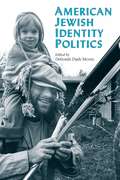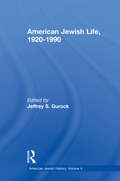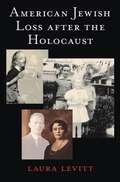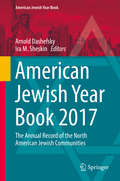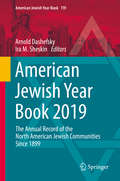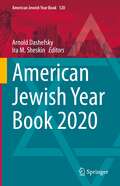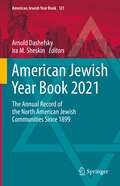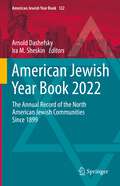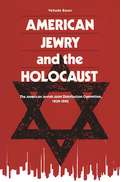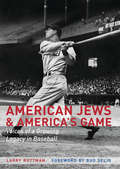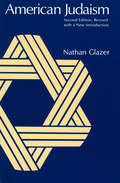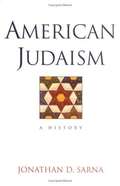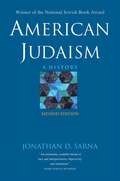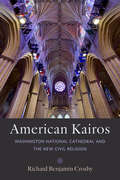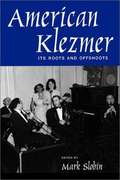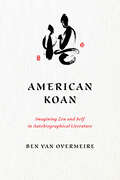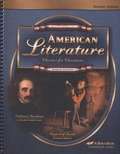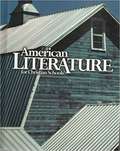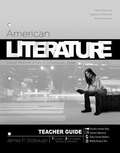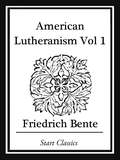- Table View
- List View
American Jewish Filmmakers
by Lester D. Friedman David DesserWoody Allen, Mel Brooks, Sidney Lumet, and Paul Mazursky, all sons of East European Jews, remain among the most prominent contemporary American film directors. In this revised, updated second edition of American Jewish Filmmakers, David Desser and Lester D. Friedman demonstrate how the Jewish experience gives rise to an intimately linked series of issues in the films of these and other significant Jewish directors. The effects of the Holocaust linger, both in gripping dramatic form (Mazursky's Enemies, a Love Story) and in black comedy (Brooks's The Producers). In his trilogy consisting of Serpico, Prince of the City, and Q&A, Lumet focuses on the failure of society's institutions to deliver social justice. Woody Allen portrays urban life and family relationships (Manhattan and Hannah and Her Sisters), sometimes with a nostalgic twist (Radio Days). This edition concludes with a newly written discussion of the careers of other prominent Jewish filmmakers such as Steven Spielberg, Barry Levinson, Brian Singer, and Darren Aronofsky.
American Jewish Identity Politics
by Deborah Dash MooreWritten by scholars who grew up after World War II and the Holocaust who participated in political struggles in the 1960s and 1970s and who articulated many of the formative concepts of modern Jewish studies, this anthology provides a window into an era of social change. These men and women are among the leading scholars of Jewish history, society and culture. The volume is organized around contested themes in American Jewish life: the Holocaust and World War II, religious pluralism and authenticity, intermarriage and Jewish continuity. Thus, it offers one of the few opportunities for students to learn about these debates from participant scholars.
American Jewish Life, 1920-1990: American Jewish History (American Jewish History #4)
by Jeffrey S. GurockThis volume contains articles on Jewish life from 1920 to the present. Its entries include studies of the economy and migration in postwar America, the impact of Holocaust survivors on American Society and the reaction to gender stereotypes within American Culture.
American Jewish Loss after the Holocaust
by Laura LevittMany of us belong to communities that have been scarred by terrible calamities. And many of us come from families that have suffered grievous losses. How we reflect on these legacies of loss and the ways they inform each other are the questions Laura Levitt takes up in this provocative and passionate book.An American Jew whose family was not directly affected by the Holocaust, Levitt grapples with the challenges of contending with ordinary Jewish loss. She suggests that although the memory of the Holocaust may seem to overshadow all other kinds of loss for American Jews, it can also open up possibilities for engaging these more personal and everyday legacies.Weaving in discussions of her own family stories and writing in a manner that is both deeply personal and erudite, Levitt shows what happens when public and private losses are seen next to each other, and what happens when difficult works of art or commemoration, such as museum exhibits or films, are seen alongside ordinary family stories about more intimate losses. In so doing she illuminates how through these “ordinary stories” we may create an alternative model for confronting Holocaust memory in Jewish culture.
American Jewish Year Book 2017: The Annual Record of the North American Jewish Communities (American Jewish Year Book #117)
by Arnold Dashefsky Ira M. SheskinThe American Jewish Year Book, now in its 117th year, is the annual record of the North American Jewish communities and provides insight into their major trends. The first chapter of Part I is an examination of how American Jews fit into the US religious landscape, based on Pew Research Center studies. The second chapter examines intermarriage. Chapters on "The Domestic Arena" and "The International Arena" analyze the year's events as they affect American Jewish communal and political affairs. Three chapters analyze the demography and geography of the US, Canada, and world Jewish populations. Part II provides lists of Jewish institutions, including federations, community centers, social service agencies, national organizations, synagogues, Hillels, day schools, camps, museums, and Israeli consulates. The final chapters present national and local Jewish periodicals and broadcast media; academic resources, including Jewish Studies programs, books, journals, articles, websites, and research libraries; and lists of major events in the past year, Jewish honorees, and obituaries.
American Jewish Year Book 2019: The Annual Record of the North American Jewish Communities Since 1899 (American Jewish Year Book #119)
by Arnold Dashefsky Ira M. SheskinPart I of each volume will feature 5-7 major review chapters, including 2-3 long chapters reviewing topics of major concern to the American Jewish community written by top experts on each topic, review chapters on "National Affairs" and "Jewish Communal Affairs" and articles on the Jewish population of the United States and the World Jewish Population. Future major review chapters will include such topics as Jewish Education in America, American Jewish Philanthropy, Israel/Diaspora Relations, American Jewish Demography, American Jewish History, LGBT Issues in American Jewry, American Jews and National Elections, Orthodox Judaism in the US, Conservative Judaism in the US, Reform Judaism in the US, Jewish Involvement in the Labor Movement, Perspectives in American Jewish Sociology, Recent Trends in American Judaism, Impact of Feminism on American Jewish Life, American Jewish Museums, Anti-Semitism in America, and Inter-Religious Dialogue in America. Part II-V of each volume will continue the tradition of listing Jewish Federations, national Jewish organizations, Jewish periodicals, and obituaries. But to this list are added lists of Jewish Community Centers, Jewish Camps, Jewish Museums, Holocaust Museums, and Jewish honorees (both those honored through awards by Jewish organizations and by receiving honors, such as Presidential Medals of Freedom and Academy Awards, from the secular world). We expand the Year Book tradition of bringing academic research to the Jewish communal world by adding lists of academic journals, articles in academic journals on Jewish topics, Jewish websites, and books on American and Canadian Jews. Finally, we add a list of major events in the North American Jewish Community.
American Jewish Year Book 2020: The Annual Record of the North American Jewish Communities Since 1899 (American Jewish Year Book #120)
by Arnold Dashefsky Ira M. SheskinThe American Jewish Year Book, which spans three different centuries, is the annual record of the North American Jewish communities and provides insight into their major trends. Part I of the current volume contains the lead article: Chapter 1, “Pastrami, Verklempt, and Tshoot-spa: Non-Jews’ Use of Jewish Language in the US” by Sarah Bunin Benor. Following this chapter are three on domestic and international events, which analyze the year’s events as they affect American Jewish communal and political affairs. Three chapters analyze the demography and geography of the US, Canada, and world Jewish populations. Part II provides lists of Jewish institutions, including federations, community centers, social service agencies, national organizations, synagogues, Hillels, camps, museums, and Israeli consulates. The final chapters present national and local Jewish periodicals and broadcast media; academic resources, including Jewish Studies programs, books, journals, articles, websites, and research libraries; and lists of major events in the past year, Jewish honorees, and obituaries. While written mostly by academics, this volume conveys an accessible style, making it of interest to public officials, professional and lay leaders in the Jewish community, as well as the general public and academic researchers. The American Jewish Year Book has been a key resource for social scientists exploring comparative and historical data on Jewish population patterns. No less important, the Year Book serves organization leaders and policy makers as the source for valuable data on Jewish communities and as a basis for planning. Serious evidence-based articles regularly appear in the Year Book that focus on analyses and reviews of critical issues facing American Jews and their communities which are indispensable for scholars and community leaders.Calvin Goldscheider, Professor Emeritus of Sociology and Ungerleider Professor Emeritus of Judaic Studies, Brown University They have done it again. The American Jewish Year Book has produced yet another edition to add to its distinguished tradition of providing facts, figures and analyses of contemporary life in North America. Its well-researched and easily accessible essays offer the most up to date scrutiny of topics and challenges of importance to American Jewish life; to the American scene of which it is a part and to world Jewry. Whether one is an academic or professional member of the Jewish community (or just an interested reader of all things Jewish), there is not another more impressive and informative reading than the American Jewish Year Book. Debra Renee Kaufman, Professor Emerita and Matthews Distinguished University Professor, Northeastern University
American Jewish Year Book 2021: The Annual Record of the North American Jewish Communities Since 1899 (American Jewish Year Book #121)
by Arnold Dashefsky Ira M. SheskinAcross three centuries, AJYB has provided insight into major trends. Part I of the current volume contains two chapters on Jewish Americans in 2020 by the Pew Research Center, including reactions from 16 prominent social scientists. Subsequent chapters analyze the development of Holocaust consciousness in America, recent domestic and international events as they affect the American Jewish community, and the demography and geography of the US, Canada, and world Jewish populations. Part II provides lists of Jewish institutions, including federations, community centers, social service agencies, national organizations, camps, museums, and Israeli consulates. The final chapters present lists of Jewish periodicals and broadcast media, Jewish Studies programs, books, journals, articles, websites, research libraries, and academic conferences and lists of major events in the past year, Jewish honorees, and obituaries. This volume employs an accessible style, making it of interest to public officials, Jewish professional and lay leaders, as well as the general public and academic researchers.For more than 120 years the American Jewish Year Book has served as an indispensable resource for scholars, clergy, and lay leaders, providing crucial, detailed insights into demographic shifts and sociological trends in the North American Jewish community. The latest edition continues to fulfill these important needs with essential articles on the landmark Pew Report and the impact of the Holocaust in the American Jewish community and American in general. This is a must-have volume for any serious student of the contemporary Jewish world.Jeffrey Shoulson, Senior Vice Provost for Academic Affairs, Professor of Literatures, Cultures, and Languages, and English, Director Emeritus Center for Judaic Studies and Contemporary Jewish Life, University of ConnecticutThe American Jewish Year Book is a critical snapshot of Jews and Jewish Studies in the United States in a particular year, and a valuable resource for scholars studying the changes in Jewish communities and Jewish Studies in the United States (and beyond!) over time. The AJYB highlights major publications and data that are consistently used in research, and its scholarly essays contextualize the information in an easily readable context. The lists of important institutions and organizations are invaluable for someone interested in the broader Jewish experience (or, at the most practical, a Jewish organization in their neighborhood!).Michelle Margolis Chesner, Norman E. Alexander Librarian for Jewish Studies, Columbia University
American Jewish Year Book 2022: The Annual Record of the North American Jewish Communities Since 1899 (American Jewish Year Book #122)
by Arnold Dashefsky Ira M. SheskinAcross three different centuries, the American Jewish Year Book has provided insight into major trends among Jews primarily in North America. Part I of the current volume contains two chapters: One is a critical assessment of the major American Jewish Population Surveys over the past fifty years (1970-2020). The second chapter is an assessment of the media coverage of Israel in the American Press. Subsequent chapters address recent domestic and international events as they affect the American Jewish community, and the demography and geography of the US, Canada, and World Jewish populations. Part II provides lists of Jewish institutions, including federations, community centers, social service agencies, national organizations, camps, museums, and Israeli consulates. The final chapters present lists of Jewish periodicals and broadcast media, Jewish Studies programs, books, journals, articles, websites, research libraries, and academic conferences as well as lists of major events in the past year, Jewish honorees, and obituaries. This volume employs an accessible style, making it of interest to public officials, Jewish professional and lay leaders, as well as the general public and academic researchers.The American Jewish Year Book is a tremendously useful resource for scholars, Jewish community professionals, pundits, clergy, and policy makers. For over a century, it has offered comprehensive insight into North American Jewish demography, sociology, and culture. It remains a vital source for comprehending the complexities of American and Canadian Jewish life.Robin Judd, Associate Professor of History and Director of the Hoffman Program for Leaders and Leadership in History, The Ohio State UniversityThe American Jewish Year Book is the first draft of history, documenting the trends and topics of interest for such an organized community. Looking through the 100+ volumes, we can track how discussions have changed over time, which concerns have returned, and how we arrived at the current point in time. It is a valuable tool for anyone interested in trends in American Jewish life.David Manchester, Director of the Berman Jewish DataBank and Director of Community Data and Research Development at The Jewish Federations of North America
American Jewish Year Book 2023: The Annual Record of the North American Jewish Communities Since 1899 (American Jewish Year Book #123)
by Arnold Dashefsky Ira M. SheskinAcross three centuries, AJYB has provided insight into major trends. Part I of the current volume contains eight chapters: The first lead chapter includes an Audit of Antisemitic Incidents in 2023 produced by the ADL, and the second chapter examines Denominational Identity and Jewish Engagement. Subsequent chapters analyze recent domestic and international events as they affect the American Jewish community, major events in the past year, and the demography and geography of the US, Canada, and World Jewish populations. Part II contains nine chapters: lists of local Jewish organizations; Jewish museums, and Holocaust museums and monuments; overnight camps; national Jewish organizations; Jewish press; Jewish academic programs; Jewish academic resources; Jewish honorees; and Jewish obituaries. This volume employs an accessible style, making it of interest to public officials, Jewish professional and lay leaders, as well as the general public and academic researchers. For more than a century, the American Jewish Year Book has served as an indispensable compendium of Jewish demographic trends, research and data. It is considered a must-read for data scientists, demographers, community leaders or anyone interested in the trends that make up the lifeblood of the Jewish experience in America. We are proud of our contributions to this essential resource. Jonathan A. Greenblatt, CEO and National Director of ADL (the Anti-Defamation League) The American Jewish Year Book is a unique resource of tremendous value to anyone interested in global Jewish life. It is critical for people today, and it will be for those who come after us. Its lists capture not only critical information about key aspects of Jewish communal life, but provide the opportunity for reflection, comparison, and analysis with other religious and ethnic communities. Riv-Ellen Prell, Professor Emerita, American Studies and the Center for Jewish Studies, University of Minnesota
American Jewry and the Holocaust: The American Jewish Joint Distribution Committee, 1939-1945
by Yehuda BauerIn this volume Yehudi Bauer describes the efforts made to aid European victims of World War II by the New York-based American Jewish Joint Distribution Committee, American Jewry's chief representative abroad. Drawing on the mass of unpublished material in the JDC archives and other repositories, as well as on his thorough knowledge of recent and continuing research into the Holocaust, he focuses alternately on the personalities and institutional decisions in New York and their effects on the JDC workers and their rescue efforts in Europe. He balances personal stories with a country-by-country account of the fate of Jews through ought the war years: the grim statistics of millions deported and killed are set in the context of the hopes and frustrations of the heroic individuals and small groups who actively worked to prevent the Nazis' Final Solution. This study is essential reading for anyone who seeks to understand the American Jewish response to European events from 1939 to 1945. Bauer confronts the tremendous moral and historical questions arising from JDC's activities. How great was the danger? Who should be saved first? Was it justified to use illegal or extralegal means? What country would accept Jewish refugees? His analysis also raises an issue which perhaps can never be answered: could American Jews have done more if they had grasped the reality of the Holocaust?
American Jews and America's Game: Voices of a Growing Legacy in Baseball
by Larry Ruttman Dr Martin Abramowitz Allan H SeligMost fans don’t know how far the Jewish presence in baseball extends beyond a few famous players such as Greenberg, Rosen, Koufax, Holtzman, Green, Ausmus, Youkilis, Braun, and Kinsler. In fact, that presence extends to the baseball commissioner Bud Selig, labor leaders Marvin Miller and Don Fehr, owners Jerry Reinsdorf and Stuart Sternberg, officials Theo Epstein and Mark Shapiro, sportswriters Murray Chass, Ross Newhan, Ira Berkow, and Roger Kahn, and even famous Jewish baseball fans like Alan Dershowitz and Barney Frank. The life stories of these and many others, on and off the field, have been compiled from nearly fifty in-depth interviews and arranged by decade in this edifying and entertaining work of oral and cultural history. In American Jews and America’s Game each person talks about growing up Jewish and dealing with Jewish identity, assimilation, intermarriage, future viability, religious observance, anti-Semitism, and Israel. Each tells about being in the midst of the colorful pantheon of players who, over the past seventy-five years or more, have made baseball what it is. Their stories tell, as no previous book has, the history of the larger-than-life role of Jews in America’s pastime.
American Judaism (The Chicago History of American Civilization)
by Nathan GlazerFirst published in 1957, Nathan Glazer's classic, historical study of Judaism in America has been described by the New York Times Book Review as "a remarkable story . . . told briefly and clearly by an objective historical mind, yet with a fine combination of sociological insight and religious sensitivity." Glazer's new introduction describes the drift away from the popular equation of American Judaism with liberalism during the last two decades and considers the threat of divisiveness within American Judaism. Glazer also discusses tensions between American Judaism and Israel as a result of a revivified Orthodoxy and the disillusionment with liberalism. "American Judaism has been arguably the best known and most used introduction to the study of the Jewish religion in the United States. . . . It is an inordinately clear-sighted work that can be read with much profit to this day."—American Jewish History (1987)
American Judaism: A History
by Jonathan D. SarnaSarna, a preeminent scholar of American Judaism (he's affiliated with Brandeis University), chronicles events, personalities, and attitudes pertaining to Jews, as well as attitudes held by Jews themselves, in the United States over a period of 350 years. He weaves the history of a people present in the United States since early colonial daysmarginalized in many ways and always worried about survivalinto the context of America's political, social, and religious life. Relevant to non-Jewish as well as Jewish communities, the themes of evolving cultural and personal identities, assimilation, and revitalization are core in both American history and contemporary American life. This thoughtful and engaging work will attract a wide scholarly and lay audience. Annotation ©2004 Book News, Inc. , Portland, OR (booknews. com)
American Judaism: A History, Second Edition
by Jonathan D. SarnaJonathan D. Sarna’s award-winning American Judaism is now available in an updated and revised edition that summarizes recent scholarship and takes into account important historical, cultural, and political developments in American Judaism over the past fifteen years. Praise for the first edition: “Sarna . . . has written the first systematic, comprehensive, and coherent history of Judaism in America; one so well executed, it is likely to set the standard for the next fifty years.”—Jacob Neusner, Jerusalem Post “A masterful overview.”—Jeffrey S. Gurock, American Historical Review “This book is destined to be the new classic of American Jewish history.”—Norman H. Finkelstein, Jewish Book World Winner of the 2004 National Jewish Book Award/Jewish Book of the Year
American Kairos: Washington National Cathedral and the New Civil Religion
by Richard Benjamin CrosbyA history of Washington National Cathedral and the theory of an American civil religion.In 1792, Pierre Charles L'Enfant, the first city planner of Washington, DC, introduced the idea of a "great church for national purposes." Unlike L'Enfant's plans for the White House, the US Capitol, and the National Mall, this grand temple to the republic never materialized. But in 1890, the Episcopal Church began planning what is known today as Washington National Cathedral. In American Kairos, Richard Benjamin Crosby chronicles the history of not only the building but also the idea that animates it, arguing that the cathedral is a touchstone site for the American civil religion—the idea that the United States functions much like a religion, with its own rituals, sacred texts, holy days, and so on. He shows that the National Cathedral can never be the church L'Enfant envisioned, but it can be a starting point for studying the conflicts over belonging, ideology, and America's place in the world that define the American civil religion. By examining correspondence between L'Enfant, George Washington, Thomas Jefferson, and others, and by diving into Washington National Cathedral's archives, Crosby uncovers a crucial gap in the formation of the nation's soul. While L'Enfant's original vision was never realized, Washington National Cathedral reminds us that perhaps it can be. The cathedral is one of the great rhetorical and architectural triumphs in the history of American religion. Without government mandate or public vote, it has claimed its role as America's de facto house of worship, a civil religious temple wherein Americans conduct some of their highest, holiest rituals, including state funerals and National Day of Prayer services.
American Klezmer: Its Roots and Offshoots
by Mark SlobinKlezmer,the Yiddish word for a folk instrumental musician, today flourishes in the United States and abroad in the world music and accompany Jewish celebrations. The essays collected in this volume investigate American klezmer: its roots, its evolution, and its spirited revitalization. The contributors offer a wide range of perspectives on the musical, social, and cultural history of klezmer in American life.
American Koan: Imagining Zen and Self in Autobiographical Literature (Studies in Religion and Culture)
by Ben Van OvermeireHow American Buddhists use Zen riddles to imagine who they are The koan is one of the most recognizable East-Asian spiritual exercises—a thought experiment in the form of a riddle or puzzle that Zen Buddhists employ to become enlightened. Well-known examples include the question &“What is the sound of one hand clapping?,&” "Does a dog have Buddha-nature?," and the injunction &“If you meet the Buddha on the road, kill him.&” In American Koan, Ben Van Overmeire examines the literary function of these ancient dialogues in autobiographies of modern Western writers such as Natalie Goldberg, Peter Matthiessen, Philip Kapleau, Ruth Ozeki, and others. Through his attentive analyses of these authors, Van Overmeire unveils the rich world of American Zen literature and delves into the meaning of success and failure in Zen; how women find a place in this patriarchal tradition; how to combine Zen insight with compassion; and the illusory nature of linear time. Critical yet empathetic, this is a scintillating study of how Americans become Buddhas.
American Literature (2nd edition)
by Raymond A. St. JohnAmerican Literature for Christian Schools tells the story of the writing done in the United States from its beginnings until the present. It covers key events, major literary movements, and principal players of a dynamic heritage that was born four centuries ago and remains today a vital expression of the heart and soul of the American people. Like other anthologies it showcases as fully as possible the rich variety and impressive appeal of the literature produced in this nation. But the book does more. It tells the story of a culture that has shifted from essential agreement with the truth of God’s Word to almost universal rejection of that truth. At times the change, as reflected in the literature, has been virtually glacial in its pace, hardly discernible to those of its day. At other times the change has been dramatic, apparent even to casual observers.
American Literature Classics for Christians (Fourth Edition)
by Pensacola Christian CollegeLaunch into literature with the exciting stories from Mark Twain, Washington Irving, Edgar Allen Poe, and many more. American Literature is a compilation of short stories, poems, and other selections that are organized by genre to exemplify the specific characteristics of the time period. Learn about the dialects in American legends, irony and satire in the short stories, local color writing during the Realistic period, and the rich imagery during the Romantic Era. With detailed information about the authors and their writing ability, literary terms and definitions, and many selections of American art, this text gives an excellent portrayal of American Literature.
American Literature Classics for Christians (Fourth Edition)
by The Editors at the Pensacola Christian CollegeThe book presents great works of American literature and evaluates them in the light of the truths of God's Word, in order that the student may further understand and articulate truth as God has established it.
American Literature for Christian Schools
by Raymond A. St. John"American Literature for Christian Schools tells the story of the writing done in the United States from its beginnings until the present. It covers key events, major literary movements and principal players of a dynamic heritage that was forn four centuries ago and remains today a vital expression of the heart and soul of the American people."
American Literature-Student
by James P. StobaughEnjoy beloved classics while developing vocabulary, reading, and critical thinking skills! Each literature book in the series is a one-year course Each chapter has five lessons with daily concept-building exercises, warm-up questions, and guided readings Easy-to-use with suggested reading schedules and daily calendar Equips students to think critically about philosophy and trends in culture, and articulate their views through writing A well-crafted presentation of whole-book or whole-work selections from the major genres of classic literature (prose, poetry, and drama), each course has 34 chapters representing 34 weeks of study, with an overview of narrative background material on the writers, their historical settings, and worldview. The rich curriculum's content is infused with critical thinking skills, and an easy-to-use teacher's guide outlines student objectives with each chapter, providing the answers to the assignments and weekly exercises. The final lesson of the week includes both the exam, covering insights on the week's chapter, as well as essays developed through the course of that week's study, chosen by the educator and student to personalize the coursework for the individual learner.
American Literature-Teacher
by James P. StobaughEnjoy beloved classics while developing vocabulary, reading, and critical thinking skills! Each literature book in the series is a one-year course Each chapter has five lessons with daily concept-building exercises, warm-up questions, and guided readings Easy-to-use with suggested reading schedules and daily calendar Equips students to think critically about philosophy and trends in culture, and articulate their views through writing A well-crafted presentation of whole-book or whole-work selections from the major genres of classic literature (prose, poetry, and drama), each course has 34 chapters representing 34 weeks of study, with an overview of narrative background material on the writers, their historical settings, and worldview. The rich curriculum's content is infused with critical thinking skills, and an easy-to-use teacher's guide outlines student objectives with each chapter, providing the answers to the assignments and weekly exercises. The final lesson of the week includes both the exam, covering insights on the week's chapter, as well as essays developed through the course of that week's study, chosen by the educator and student to personalize the coursework for the individual learner.
American Lutheranism
by Friedrich Bente"American Lutheranism Vol 1" is a religious text written by Friedrich Bente.

